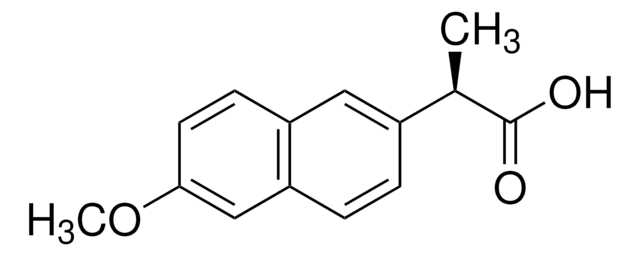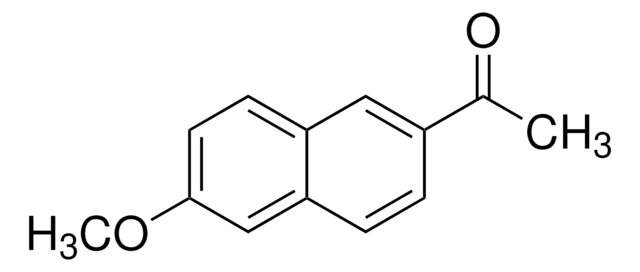1457301
USP
Naproxen
United States Pharmacopeia (USP) Reference Standard
Sinónimos:
(S)-(+)-2-(6-Methoxy-2-naphthyl)propionic acid
About This Item
Productos recomendados
grado
pharmaceutical primary standard
familia API
naproxen
fabricante / nombre comercial
USP
técnicas
HPLC: suitable
gas chromatography (GC): suitable
mp
152-154 °C (lit.)
aplicaciones
pharmaceutical (small molecule)
Formato
neat
cadena SMILES
COc1ccc2cc(ccc2c1)[C@H](C)C(O)=O
InChI
1S/C14H14O3/c1-9(14(15)16)10-3-4-12-8-13(17-2)6-5-11(12)7-10/h3-9H,1-2H3,(H,15,16)/t9-/m0/s1
Clave InChI
CMWTZPSULFXXJA-VIFPVBQESA-N
Información sobre el gen
human ... PTGS1(5742) , PTGS2(5743)
¿Está buscando productos similares? Visita Guía de comparación de productos
Descripción general
Aplicación
- Dexamethasone Compounded Oral Suspension
- Naproxen
- Naproxen Compounded Oral Suspension
- Naproxen Delayed-Release Tablets
- Naproxen Oral Suspension
- Naproxen Tablets
- Terazosin Tablets
Acciones bioquímicas o fisiológicas
Nota de análisis
Otras notas
Producto relacionado
Palabra de señalización
Warning
Frases de peligro
Consejos de prudencia
Clasificaciones de peligro
Acute Tox. 4 Oral - Aquatic Chronic 2 - Eye Irrit. 2 - Repr. 2 - Skin Irrit. 2 - STOT SE 3
Órganos de actuación
Respiratory system
Código de clase de almacenamiento
11 - Combustible Solids
Clase de riesgo para el agua (WGK)
WGK 3
Elija entre una de las versiones más recientes:
Certificados de análisis (COA)
It looks like we've run into a problem, but you can still download Certificates of Analysis from our Documentos section.
Si necesita más asistencia, póngase en contacto con Atención al cliente
¿Ya tiene este producto?
Encuentre la documentación para los productos que ha comprado recientemente en la Biblioteca de documentos.
Los clientes también vieron
Nuestro equipo de científicos tiene experiencia en todas las áreas de investigación: Ciencias de la vida, Ciencia de los materiales, Síntesis química, Cromatografía, Analítica y muchas otras.
Póngase en contacto con el Servicio técnico









